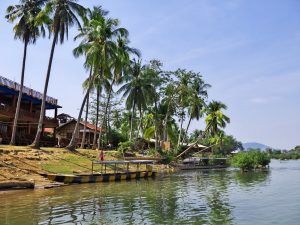The rapid expansion of hydropower dam developments in the Lower Mekong basin could undermine important regional supply chains and threaten the viability of multi-billion-dollar industries, the World Wildlife Fund (WWF) claims in a new report.
While there has been a lot of attention on the environmental and social impacts of dam projects on the Mekong and its tributaries, the report, released yesterday, highlights the possible indirect negative impacts on five industries: energy production, fisheries and aquaculture, rice production, sand mining, and textiles and electronics.
The WWF report sets out to qualify the claims of some lower Mekong nations that hydropower is a key to untold economic growth, citing one estimate that dams could generate up to $33 billion of economic benefits. It claims that “these arguments have been based on the purported benefits to the energy sector, with little consideration, or understanding, of the implications for other economic sectors.”
The lower half of the Mekong River has seen intensive hydropower development in recent years. In Laos, there are now two dams on the mainstream of the Mekong River, with another seven in progress, while Cambodia has plans (currently on hold) for two more. There are many more planned and existing dams on the Mekong’s various tributaries. By 2030, there could be over 130 dams on the Lower Mekong and its tributaries, according to one assessment.
As a result, the report notes, mainland Southeast Asia’s great artery is “no longer a free-flowing river,” a fact that has implications. Dams on the Mekong and its tributaries have blocked fish migration channels and trapped nutrient-rich sediment, leading to erosion, falling water levels, and saltwater intrusion in the Mekong Delta.
As the WWF notes, however, official considerations of the risks related to hydropower generally remain limited to the immediate, geographically concentrated impacts – such as floods and the displacement of local communities – rather than the long-term, cumulative impacts on ecological systems.
“As such,” the report states, “the benefits of hydropower as a low-carbon energy source for climate change mitigation are often grossly overestimated at the expense of long-term systemic risks posed by hydropower – not only in terms of environmental externalities, but also broader implications for society and economic sectors beyond the energy sector.”
In addition to affecting the food security of more than 50 million people, and supporting an unusual amount of biodiversity, the lower Mekong nations – Vietnam, Cambodia, Laos, and Thailand – “all benefit economically from the river, with natural resource-based supply chains contributing to both domestic and global markets.” A number of social-economic risks flow from these impacts, such as falling household incomes, food scarcity, rural labor migration, and tighter regulations on industry – all of which could have cascading economic impacts over the long term.
In general, the impacts differ between the four countries, a reflection of “national variations in both the resource-dependency of industry and the relative maturity of those supply chain industries.”
It found that supply chains in Vietnam and Cambodia “face the highest risks from hydropower due to the high exposure of supply chains to hydropower threats, such as sediment loss and river fragmentation, combined with relatively high vulnerability of these sectors.”
For Vietnam, hydropower development poses long-term risks to the agriculture, textiles, electronics, and energy generation industries, much of which are concentrated in the Mekong Delta, the report claims. In Cambodia, the risk is concentrated in the fisheries and aquaculture sector, given the “vulnerability of the Tonle Sap Lake’s fisheries, which are critical for livelihoods and food security.”
The report highlights recent research that the fisheries and aquaculture industry is estimated to face financial losses of up to $21 billion with a potential decline in Mekong fisheries of 30-40 percent. Cambodia’s Tonle Sap Lake alone is facing a 40-57 percent reduction in production losses by 2030.
Supply chains in Lao PDR and Thailand face relatively lower risks overall, the WWF found. However, Laos faces relatively high risks to its power generation sector, which is heavily reliant on hydropower dams and is therefore vulnerable to dry spells and low river levels. This poses additional risks due to “the financial and market risks this dependency entails.”
After years of watching lower Mekong governments shrug off warnings about the social and environmental impacts of dam construction, WWF is hoping that they will come to recognize the extent to which the health of the Mekong is intimately if indirectly, connected to the health and prosperity of the region’s economies as a whole. After all, what is bad for the environment sooner or later is also bad for the bottom line.

































